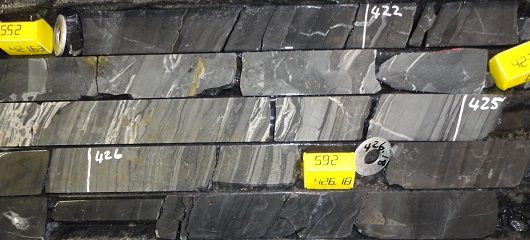Biogenic haze formation fuelled planetary oxidation

Billions of years ago the young planet Earth was much different from the one we inhabit today, with wildly fluctuating surface temperatures and an atmosphere and oceans filled with gases toxic to life as we know it.
Understanding how we got from that inhospitable place to today’s world of mild climates and air-breathing creatures is a fundamental question in Earth sciences.
New research led by the School of Earth & Environmental Sciences at the University of St Andrews suggests that the key to solving this mystery lay in the run-up to planetary oxygenation. These researchers reconstructed atmospheric chemistry during the time period immediately before the Great Oxidation Event (GOE), the singular event 2.3 billion years ago when oxygen concentrations in the Earth’s atmosphere increased by over 10,000 times.
 In a paper published today in Proceedings of the National Academy of Sciences, the St Andrews group propose a new contributing cause for the event that literally changed the face of the Earth.
In a paper published today in Proceedings of the National Academy of Sciences, the St Andrews group propose a new contributing cause for the event that literally changed the face of the Earth.
Dr Aubrey Zerkle explained: “Our new dataset constitutes the highest resolution record of Archean atmospheric chemistry ever produced, and paints a dramatic picture of Earth surface conditions before the oxygenation of our planet.
“These data show unequivocally that biology fuelled a methane-rich hydrocarbon atmosphere, similar to that of Saturn’s moon Titan, for millions of years at a time. High methane levels meant that more H2, the main gas preventing the build-up of oxygen, could escape into outer space, paving the way for global oxygenation.”
Dr Gareth Izon, lead author of the study (formerly at St Andrews, now at MIT), said: “Reconstructing the evolution of atmospheric chemistry has long been the focus of geochemical research; however, the utility of our geochemical toolbox is rarely without inference.”
Dr Izon explained that the discovery of anomalous sulphur-isotope fractionation has lifted some of these uncertainties. “Our new data show that the chemical composition of the atmosphere was dynamic and, at least in the prelude to the GOE, hypersensitive to biological regulation,” he said.
Co-author Dr Mark Claire, St Andrews School of Geography and Geosciences, who led the numerical simulations of Archean atmospheric chemistry, said: “We have demonstrated that organic haze imparts observable signatures into the rock record. This paves the way for quantitative constraints on the chemistry of the early atmosphere.”
Photo captions
Top: the cores studied by the research group © Gareth Izon
Bottom & news page: Titan taken from NASA’s Cassini mission
More information
‘Biological regulation of atmospheric chemistry en route to planetary oxygenation’, Gareth Izon, Aubrey Zerkle, Kenneth H Williford, James Farquar, Simon W Poulton and Mark W Claire, is published in the Proceedings of the National Academy of Sciences.
This work was funded by the UK Natural Environmental Research Council (Grants NE/H016805 & NE/J023485) and by the European Research Council (ERC) under the European Union’s Horizon 2020 research and innovation programme (grant agreement No 678812).
Issued by the University of St Andrews Communications Office, contactable on 01334 467310 or [email protected].
Category Research